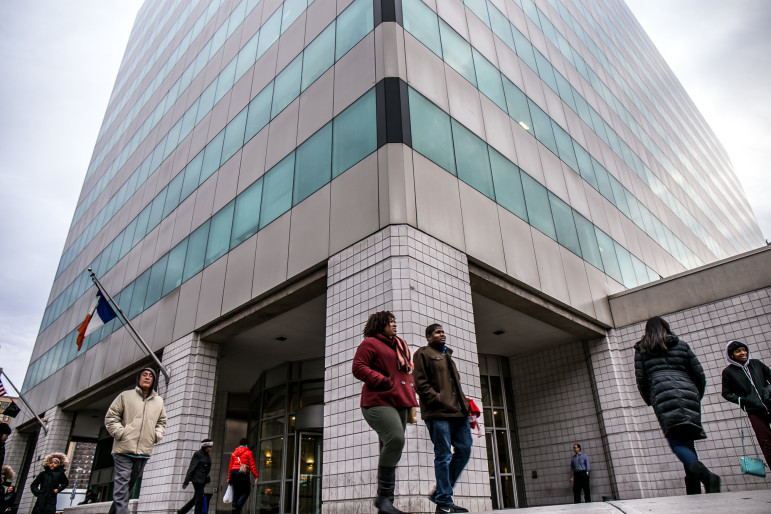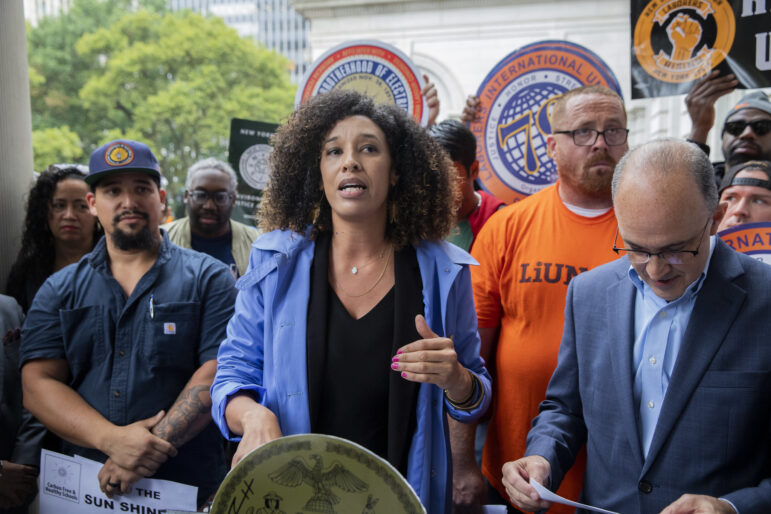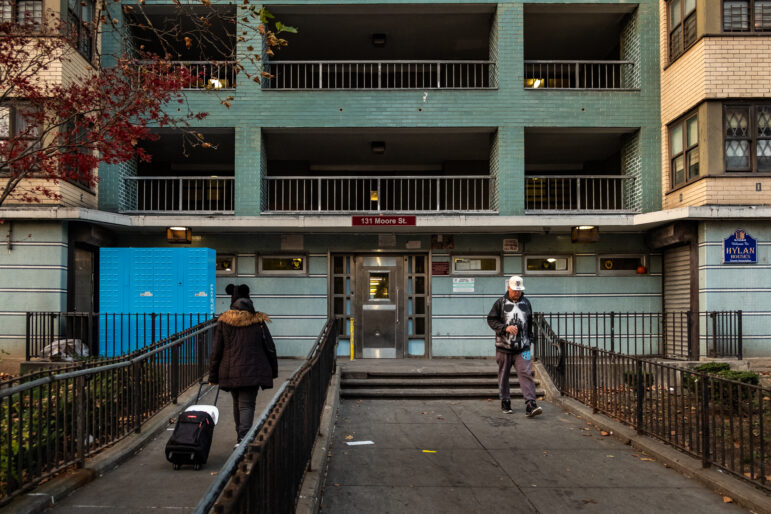
Adi Talwar
The Bronx DA's office building, 198 E. 161st Street.
Three years into his 20-years-to-life term for a killing in the Bronx that he insisted he did not commit, Luis Paulino sent a letter in August 2000 from Eastern Correctional Facility in upstate Napanoch to the office that prosecuted him—the district attorney of Bronx County.
Under the state Freedom of Information Law, Paulino requested crime scene, witness and forensic reports from his criminal case file. Although he had already appealed his second-degree murder conviction and lost, Paulino’s goal “was that once armed with this additional information or evidence he would eventually be able to prove his innocence resulting in his vindication,” according to later court filings.
In 2001, the DA’s staff told Paulino that despite a “diligent search” they could not locate his file. Paulino sent similar requests later in 2001 and again in 2006, but each time heard the same reply: The evidence that had put him behind bars could not be found. He sued but a judge issued a one-paragraph ruling saying, in essence, that he could not order the DA to hand over papers that weren’t there.
Paulino, 42, was paroled in June 2014 after serving 17 years and could not be located to comment for this story. His lawsuit was one of at least seven similar actions from recent years against the office of Robert Johnson, who recently stepped down as district attorney to become a state judge. In each case, an inmate—apparently asserting his innocence—requested documents and encountered roadblocks at the DA’s office.
The lawsuits represent a tiny sliver of the more than 3,000 felony cases a year handled in the Bronx over the period spanned by the inmates’ claims. Some of the inmates’ arguments of innocence seem specious, and a few have been paroled in spite of their supposed trouble getting information about their cases.
But in an era when the integrity of convictions—even those going back decades—has come into question, the obstacles that confronted these inmates suggest there are may be ways to improve how New York State criminal justice records are handled. A staffer for the Bronx district attorney tells City Limits that as many as one in five criminal case files requested via FOIL cannot be found.
Keep, then destroy
New York State’s judiciary law says that district attorneys can ask their local appellate courts for permission to “destroy, sell or otherwise dispose of … any records, books or papers in the care, custody or control of the district attorney which are more than twenty-five years old and are no longer in current use” if keeping them would “serve no legal, practical or useful purpose.”
Until case files are destroyed, they are subject to the state’s open records or freedom of information law, which requires that “each agency shall, in accordance with its published rules, make available for public inspection and copying all records,” with a few exceptions, like documents containing information that would violate a person’s privacy, or that contain information on confidential informants.
The Committee on Open Government, a New York State office that provides legal guidance about the FOI law, has said district attorneys don’t have to provide transcripts and other materials that might be considered “court records,” since those items would be under the control of courts. And according to advisory opinions issued by the committee, DAs don’t have to hand over records that they previously gave to the same requester. But that leaves a lot of paperwork as fair game.
Rafael Curbelo, an assistant Bronx DA who oversees records-access requests, tells City Limits that he receives hundreds of FOIL requests each year. The majority of them come from inmates.
The office has a timetable governing when it requests permission from a judge to destroy files, Cubelo notes. “The retention schedule varies with the severity of the crime,” he says. “With homicides, we hold on to it forever.”
The motivation to shred records, he says, is a shortage of space. “As we move forward hopefully we can scan more of the material. At least we would have something, we would have a record,” Curbelo adds. “That’s the future.”
Lost files, disputed access
The present, however, is one in which case files sometimes cannot be located.
In November 2010, Jerry Ray—locked up at Orleans Correctional Facility for burglary in the second degree—requested records of NYPD radio transcripts, 911 tapes and memo-book entries by police officers. When Ray hadn’t heard back about the 2010 request by the following February, he wrote to the DA again. Three days later Ray received a letter back from the Bronx District Attorney’s Office stating his FOIL had been denied because the files couldn’t be found. Ray has since been paroled, but his FOIL lawsuit ended inconclusively, according to available court files.
Kasiem Chaves ran into the same problem a few years earlier. Imprisoned since 1984 for a shooting a year earlier inside a store on Fordham Road that left one man dead and another wounded, Chaves in 2005 requested copies of a laundry list of documents related to this case like memos, reports and the documents associated with the handling of physical evidence. The request was denied “on the ground that the trial folder could not be found despite a diligent search.” In fact, the DA’s office mounted three separate attempts to find the files over three years, according to court filings by the office. Chaves did obtain documents related to his appeal, but never received the paperwork he wanted pertaining to his original trial.
Chaves told City Limits in a recent letter that his priority is to track down a gunshot residue test that he believes would show he had not fired a gun. “The results of the test procedures on me and my clothes were negative,” he wrote. (Most literature on the subject indicates that gun-shot residue tests are only able to detect residue within two days after a gun is fired. The test Chaves seeks apparently occurred beyond that window, making it unclear what bearing it would have on his case.)
Chaves’ case made it all the way to an appeals court, which sided with the Bronx DA on the grounds that the case was old. “[The DA] was under no obligation to maintain evidence after all appeals had been exhausted … and was not under an obligation to maintain that evidence for more than 25 years after [Chaves’] convictions,” a 2009 ruling read.
In other cases, inmates claim to have never heard back from the DA about their requests for information before they sued.
Joseph Sanchez was convicted of second-degree murder and manslaughter in May of 2011 and has been serving his sentence at the Greenhaven facility in Stormville New York. Sanchez was sentenced to 46 years to life and is not eligible for parole until September 11, 2053. He requested via FOIL in August of 2011 copies of property vouchers of blood samples and notes from a Detective Diskin. Sanchez claimed in a suit filed in 2012 that Johnson’s office never replied to the request. While he now says he has received some documents in that case, he has filed a second suit over access to other documents. “The reason I am seeking these documents is because the assistant district attorney made statements at my trial which I believe are false and misleading but without proof I cannot make these claims,” Sanchez wrote in a recent letter.
Freddie Gonzalez is presently an inmate at Sing Sing Correctional Facility. He was sentenced in 1996 to 58 years to life for murder and attempted murder, both in the second degree. On August 19, 2014 he sent a FOIL request to the Bronx District Attorney’s Office. He received a response on August 25 acknowledging the request. Gonzalez sued Johnson last March for failure to provide the desired documents. Their last court hearing was on September 21. Gonzalez, who is hoping to prove that one of the witnesses who testified against him lied, tells City Limits: “It is very easy to be lost in the system when you don’t have money or someone who does.”
Rohelio Maldonado has been in state prison since 2004 for a 34-years-to-life sentence for murder and two counts of attempted murder. In the summer of 2014 he filed a FOIL request from Clinton Correctional Facility asking for documents and evidence of every description pertaining to his case. He received an acknowledgement of his request, but nothing else. He filed an appeal with the DA’s FOIL unit, then launched a lawsuit in March of last year.
Court records indicate both Gonzalez and Maldonado’s suits are ongoing.
What to show and what to keep
Freedom of information isn’t free: Most agencies charge a copying fee and the Bronx DA is no exception. It’s 25 cents per page, covered by inmates’ lawyers or families, or their own commissary account. But those fees don’t support an extensive staff: It’s Curbelo and one paralegal working their way through hundreds of cases each year. “We’re able to, I think, meet our obligations,” he says.
“We do get a lot of requests. There are only two of us. I encourage requesters to remind us: If you haven’t heard from us recently to put a bug in your era,” Curbelo suggests.
“I think If we handled one case a year it’d be very easy to find. And given the sheer number of cases we handle and the number of people who need the file sometimes, it is rather difficult to locate a file,” he continues. “Although we’re improving, historically maybe 15 or 20 percent of the files for whatever reason cannot be located.”
Even if a file is found, its contents might not be released. Curbelo says grand jury minutes, the identity of sex-crime victims and autopsy reports are off limits. He also avoids releasing crime-scene photos. “I withhold those because the family is entitled to some privacy,” he says. “I always have to keep in mind anything I disclose via FOIL, I essentially am saying this is disclosable to the public.”
A defense attorney who spoke to City Limits, but asked not to be named, noted that not all evidence from a criminal case winds up with the DA. Particularly if the case ends with a plea bargain instead of a trial, as the vast majority of cases do, the DA’s file may lack evidence collected by the police.

Acroterrion, Medic 18, Bubby 1124, Jayu
Some of the facilities from which the FOIL requests came. Clockwise from top left: Attica, Eastern, Clinton and Sing Sing.
The other boroughs
Among the many concerns raised in recent years about the criminal justice system—over the reliability of eyewitness testimony, disparities in drug sentences, rogue detectives—freedom of information disputes appear to be a fairly obscure topic. None of the indigent defense agencies contacted by City Limits had much to say about the issue. That could be chalked up to the fact that the injured parties here have already been convicted and are largely representing themselves.
What is clear is that the FOIL issue has come up in other boroughs as well, and that the disputes can get very complicated.
Candido Baez, a convicted murderer currently serving 29 years to life in Greene Correctional Facility, claims he has been involved in FOIL disputes with the Queens DA since 1990. After he filed a new request in 2008, he did receive 78 documents, for which he says he paid $1,500 in fees, but he claims the “copies were so poor that you could not read or tell what was written on the documents or what was illustrated on the photographs.” Baez tried to get a larger set of documents, but state judges shot him down three years ago, saying that victim’s autopsy results were private and that prosecutor’s notes were exempt from FOIL because they are “attorney work product.”
The court did order the Queens DA to send Baez cleaner copies of the illegible files he’d received earlier. He claims in a letter never to have received them. “What I am hoping to find in these documents are numerous information that will demonstrate that I am actually innocent of the crime that I have been wrongfully convicted of for the last 26 years and 8 months,” Baez writes.
Some cases drag on for more than a decade, and not necessarily because of the DA. Ubaldo Romero, convicted in 2002 of two 1990 murders, FOILed the Manhattan DA in 2003 for records related to his case. The DA turned the request down for two reasons. One was that Romero was appealing his criminal conviction, making the documents off limits under state law because they were part of an ongoing criminal case. That obstacle eventually disappeared: Romero saw two rounds of appeals-court action and came out a loser both times.
But the DA also claimed the paperwork had been turned over to Romero’s original lawyer. Open records law says agencies don’t have to keep issuing the same papers to the same people. But since long-term inmates often lose touch with their original lawyers, this quirk of the law traps documents in a limbo—ostensibly in possession of a lawyer who has nothing to do with the inmate anymore. (In Chaves case, for instance, his original lawyer was disbarred and then died.)
Romero was able to show the court that his original lawyer was no longer involved, and courts ordered the DA to comply with his request. The DA produced a single document, saying that was all Romero had asked for. In 2007, it ordered the DA to look for and provide all the documents Romero sought.
An assistant DA told Romero by letter that year that he’d identified just under 2,400 documents to hand over. The DA refused to hand over some parts of the case file, however, citing the nature of the crime Romero is convicted of committing: Namely, that Romero ran an East Harlem narcotics ring and murdered two men who were robbing drug-dealers. The prosecutor said “death threats against witnesses” hampered the second of three attempts to try Romero and co-defendants on those charges.
“In short,” the assistant DA, Charles King, wrote in 2007, “you are an extremely violent individual who has a history of threatening witnesses. There is a legitimate fear that if you are granted unfettered access to the files related to your case, you would use that information to exact retribution against those whose testimony and cooperation with law enforcement resulted in your life sentence.” King also refused to hand over “photographs of the murder victims after you and your co-defendants shot them,” citing privacy concerns.
In a recent letter to City Limits, Romero said he had finally obtained in 2015 the records he’d been seeking: “After many years of trying to get these documents, someone sent me $589.50 to get copies of these documents. I couldn’t earn that amount of money from attending my program here in prison, so I had to wait for years until I decided to ask a friend for help.” He said he still wanted more documents and that he is trying to prove that “the prosecution’s witnesses … all lied during their sworn testimony.”
Romero now has a new lawyer. The Manhattan DA just sent a copy of the FOILed files to that attorney, free of charge.









One thought on “Inmates Want Files to Prove Innocence. DA Can’t Find Them.”
Anything Charles King says should be taken with a grain of salt. He was provided with irrefutable evidence that a prosecutor from his office admitted coaching a woman’s identification of a man in a rape case in 1982 (with the woman testifying that she never independently identified him). That same prosecutor then coached two other people in a failed post-trial effort to identify that man in another case where the two perpetrators had already been identified by the police two years earlier. Charles King upheld that man’s criminal conviction and 30 years of imprisonment on behalf of the New York City District Attorney’s Conviction Integrity Unit. Clearly, The Dred Scottsboro Rule is in full effect in the New York criminal “justice” system.